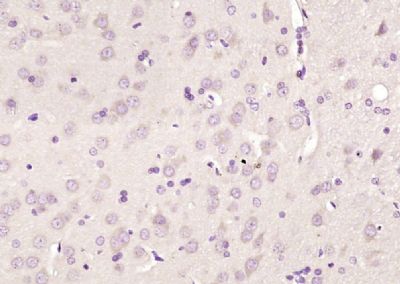beta B1 Crystallin Polyclonal Antibody
Purified Rabbit Polyclonal Antibody (Pab)
- SPECIFICATION
- CITATIONS
- PROTOCOLS
- BACKGROUND

Application
| IHC-P, IHC-F, IF, ICC, E |
|---|---|
| Primary Accession | P53674 |
| Reactivity | Rat, Pig, Dog |
| Host | Rabbit |
| Clonality | Polyclonal |
| Calculated MW | 28 KDa |
| Physical State | Liquid |
| Immunogen | KLH conjugated synthetic peptide derived from human beta B1 Crystallin |
| Epitope Specificity | 101-200/252 |
| Isotype | IgG |
| Purity | affinity purified by Protein A |
| Buffer | 0.01M TBS (pH7.4) with 1% BSA, 0.02% Proclin300 and 50% Glycerol. |
| SIMILARITY | Belongs to the beta/gamma-crystallin family. Contains 4 beta/gamma crystallin 'Greek key' domains. |
| SUBUNIT | Homo/heterodimer, or complexes of higher-order. The structure of beta-crystallin oligomers seems to be stabilized through interactions between the N-terminal arms. |
| Post-translational modifications | Specific cleavages in the N-terminal arm occur during lens maturation and give rise to truncated forms, leading to impaired oligomerization and protein insolubilization. |
| DISEASE | Defects in CRYBB1 are the cause of cataract congenital nuclear autosomal recessive type 3 (CATCN3) [MIM:611544]. A congenital cataract affecting the central nucleus of the eye. Nuclear cataracts are often not highly visually significant. The density of the opacities varies greatly from fine dots to a dense, white and chalk-like, central cataract. The condition is usually bilateral. Nuclear cataracts are often combined with opacified cortical fibers encircling the nuclear opacity, which are referred to as cortical riders. Defects in CRYBB1 are a cause of cataract-microcornea syndrome (CAMIS) [MIM:116150]. An ocular disorder characterized by the association of congenital cataract and microcornea without any other systemic anomaly or dysmorphism. Clinical findings include a corneal diameter inferior to 10 mm in both meridians in an otherwise normal eye, and an inherited cataract, which is most often bilateral posterior polar with opacification in the lens periphery. The cataract progresses to form a total cataract after visual maturity has been achieved, requiring cataract extraction in the first to third decade of life. Microcornea-cataract syndrome can be associated with other rare ocular manifestations, including myopia, iris coloboma, sclerocornea and Peters anomaly. Transmission is in most cases autosomal dominant, but cases of autosomal recessive transmission have recently been described. |
| Important Note | This product as supplied is intended for research use only, not for use in human, therapeutic or diagnostic applications. |
| Background Descriptions | Crystallins are the major proteins of the vertebrate eye lens, where they maintain the transparency and refractive index of the lens. Crystallins are divided into Alpha, Beta, and Gamma families, and the Beta- and Gamma-crystallins also comprise a superfamily. Crystallins usually contain seven distinctive protein regions, including four homologous motifs, a connecting peptide, and N- and C-terminal extensions. Beta-crystallins constitute the major lens structural proteins, and they associate into dimers, tetramers, and higher order aggregates. The Beta-crystallin subfamily is composed of several gene products, including Beta A1-, Beta A2-, Beta A3-, Beta A4-, Beta B1-, Beta B2- and Beta B3-crystallin. The Beta A1- and Beta A3-crystallin proteins are encoded by a single mRNA. They differ by only 17 amino acids, and Beta A1-crystallin is generated by use of an alternate translation initiation site. |
| Gene ID | 1414 |
|---|---|
| Other Names | Beta-crystallin B1, Beta-B1 crystallin, CRYBB1 |
| Dilution | IHC-P=1:100-500,IHC-F=1:100-500,ICC=1:100-500,IF=1:100-500,ELISA=1:5000-10000 |
| Storage | Store at -20 ℃ for one year. Avoid repeated freeze/thaw cycles. When reconstituted in sterile pH 7.4 0.01M PBS or diluent of antibody the antibody is stable for at least two weeks at 2-4 ℃. |
| Name | CRYBB1 |
|---|---|
| Function | Crystallins are the dominant structural components of the vertebrate eye lens. |

Thousands of laboratories across the world have published research that depended on the performance of antibodies from Abcepta to advance their research. Check out links to articles that cite our products in major peer-reviewed journals, organized by research category.
info@abcepta.com, and receive a free "I Love Antibodies" mug.
Provided below are standard protocols that you may find useful for product applications.
If you have used an Abcepta product and would like to share how it has performed, please click on the "Submit Review" button and provide the requested information. Our staff will examine and post your review and contact you if needed.
If you have any additional inquiries please email technical services at tech@abcepta.com.













 Foundational characteristics of cancer include proliferation, angiogenesis, migration, evasion of apoptosis, and cellular immortality. Find key markers for these cellular processes and antibodies to detect them.
Foundational characteristics of cancer include proliferation, angiogenesis, migration, evasion of apoptosis, and cellular immortality. Find key markers for these cellular processes and antibodies to detect them. The SUMOplot™ Analysis Program predicts and scores sumoylation sites in your protein. SUMOylation is a post-translational modification involved in various cellular processes, such as nuclear-cytosolic transport, transcriptional regulation, apoptosis, protein stability, response to stress, and progression through the cell cycle.
The SUMOplot™ Analysis Program predicts and scores sumoylation sites in your protein. SUMOylation is a post-translational modification involved in various cellular processes, such as nuclear-cytosolic transport, transcriptional regulation, apoptosis, protein stability, response to stress, and progression through the cell cycle. The Autophagy Receptor Motif Plotter predicts and scores autophagy receptor binding sites in your protein. Identifying proteins connected to this pathway is critical to understanding the role of autophagy in physiological as well as pathological processes such as development, differentiation, neurodegenerative diseases, stress, infection, and cancer.
The Autophagy Receptor Motif Plotter predicts and scores autophagy receptor binding sites in your protein. Identifying proteins connected to this pathway is critical to understanding the role of autophagy in physiological as well as pathological processes such as development, differentiation, neurodegenerative diseases, stress, infection, and cancer.


